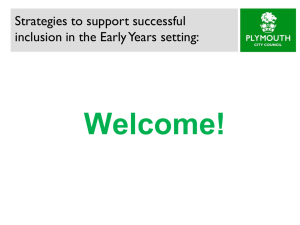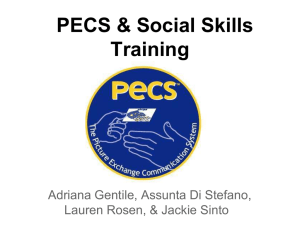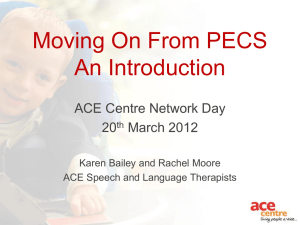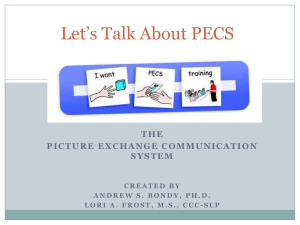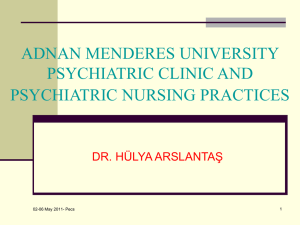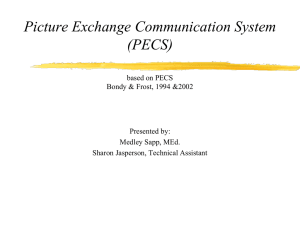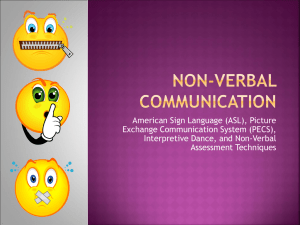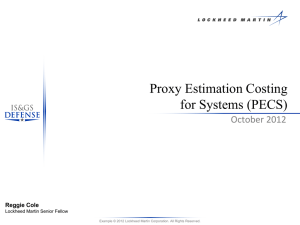Why pecs? - Child Early Intervention Medical Center
advertisement
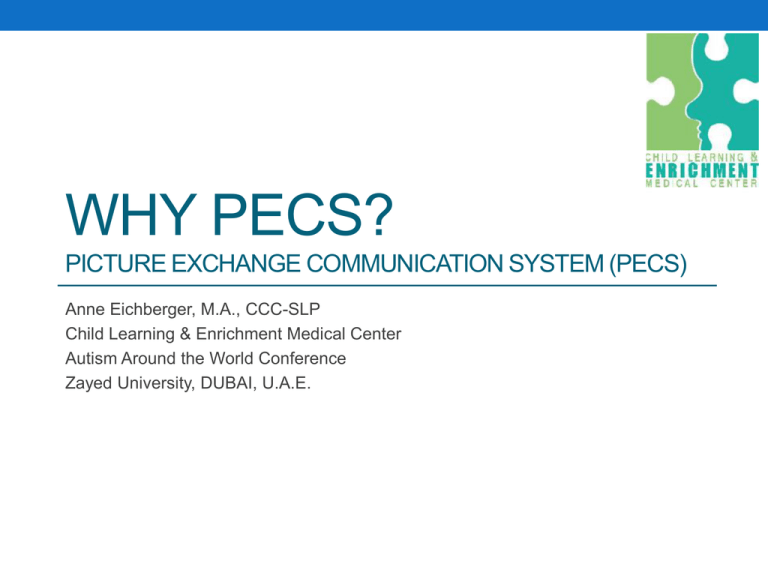
WHY PECS? PICTURE EXCHANGE COMMUNICATION SYSTEM (PECS) Anne Eichberger, M.A., CCC-SLP Child Learning & Enrichment Medical Center Autism Around the World Conference Zayed University, DUBAI, U.A.E. Objectives To summarize the basic theory of Picture Exchange Communication System (PECS) To address the myths that surround PECS To determine the efficacy of the intervention by literature review in narrative form Why do we communicate? • To express needs and wants • To develop social closeness • To exchange information • To fulfill social etiquette routines Light 1988 Challenges • An estimated 1/3 to 1/2 of children and adults with autism do not use speech functionally. (National Research Council, 2001) Non-Functional Speech Difficulties Frustration Confrontation, Tantrums Learned helplessness Loss of independence reliance on others Lack of control over decisions Communication Bill of Rights “All persons, regardless of the extent of their disability, have a basic right to affect, through communication, the conditions of their own existence.” (National Joint Committee for the Communicative Needs of Persons with Severe Disabilities, 1992) #1 Right… The right to request desired objects, actions, events, persons and to express personal preferences or feelings. Augmentative and Alternative Communication (“AAC”) Techniques Symbols/Aids Strategies AAC ASHA 1991 What is PECS? • Developed by Andy Bondy, Ph.D. & Lori Frost, M.S., CCC-SLP in 1985 • Teaches functional communication that is immediately useful by exchanging visual symbols for communication purposes • Based on principles of Applied Behavior Analysis and on B.F. Skinner’s 1957 book, “Verbal Behavior” • Fields of applied behavioral analysis + speech-language pathology = effective method of teaching functional communication Bondy & Sulzer-Azaroff 2002 What does the child learn? What does the Child Learn? • Initiation: child learns to be spontaneous and act without prompting, more control over self-expressions • Concrete Outcomes: receiving a tangible, desired item teaches the child to value the act of communicating with others and is a powerful motivator to drive learning • Social Context: skills generalized in order to be used in a variety of environments Components • Participants • Reinforcer • Velcro book How does PECS Work? phrases Target Skill Phase 1 Physical exchange of picture Phase 2 Distance and persistence Phase 3 Picture discrimination Phase 4 Building Sentences and Attributes Phase 5 Answering “What do you want?” Phase 6 Responsive and spontaneous commenting Possible PECS Candidate? Is the student using functional communication? NO YES PECS may be appropriate Is the student’s communication understandable to unfamiliar listeners? NO YES Is the student initiating communication? PECS may be appropriate NO PECS may be appropriate YES Are the student’s mean length of utterance and vocabulary size adequate? NO YES PECS may be appropriate PECS is NOT appropriate PECS Popularity • Clear and intentional • Requires few motor movements • Meaningful and motivating • Inexpensive and portable • Large number of communicative partners Myths PECS is only used for people who don’t speak at all • System targets initiation and purpose PECS only teaches the child to learn to request using single words • Requesting is the first skill taught • Progresses to using sentence structure, answering questions, and finally expands to commenting. Myths If PECS is used, the learner won’t learn how to speak. • Research conducted over the past 30 years has demonstrated that augmentative and alternative communication strategies do not inhibit the development of speech. Many researchers have reported a facilitation of speech when AAC strategies are used. • Schwartz, Garfinkle, and Bauer (1998) children who initially had a limited spontaneous vocal repertoire continued to have increases in spontaneous language following PECS training. Myths If the child is starting to speak, stop PECS immediately • No evidence to support that taking away pictures will promote more speech • Anecdotal information shows the opposite effect • If you take away skills (by taking away pictures) that is unethical Cognitive Basis of Autism: Profile of Cognitive Strengths/Weaknesses (Minshew, Goldstein & Siegel, 1997; Williams, Goldstein & Minshew, 2006) Intact abilities Attention Sensory perception Elementary motor Simple memory Rule-learning Visiospatial processing Cognitive weakness Complex sensory Complex motor Complex memory Complex language Complex formation Why is Language Processing Difficult? • Functional Magnetic Resonance Imaging (fMRI) study • Kana 2006; adults with autism used brain areas typically associated with visual imagery even if these areas were not needed for the language processing task • Koshino et al., 2005; individuals with autism did not automatically recode visual information into language, potentially making it more difficult for them to use language to scaffold learning and memory processes Implications for Language Intervention Visually based supplementation increases understanding by: • Making concepts more understandable • Making material is stable over time • Creating an “eye-catcher” for capturing and maintaining attention • Prompting the student • Helping minimize anxiety (Twachtman-Cullen 1998) A Review of the Efficacy of PECS Intervention Deborah Preston & Mark Cater 2009 Search Strategy: 1. 2. 3. Journal articles 1992- 2007 Used PECS as whole or part of an intervention strategy Results had to include data on results of intervention Research Design: • 456 participants in 27 studies • Ages: 20 months – 40 years • 88% received PECS intervention, 14% non – or alternative intervention groups • Single-subject studies • Randomized control trials • 377 (83%) were described as having ASD • Group Designs • 43% males, 8% females, 48% gender unstated • Settings: various Efficacy & Effectiveness Total group of 394 individuals who received PECS intervention A great majority successfully mastered at least some phases of PECS, however 3 individuals were unsuccessful • Liddle 2001; child reported as being unsuccessful at mastering phase 1 • Soner et al 2006; 1 adult had difficulty with motor and cognitive demands of training • Ticani 2004; 1 adult was more successful with manual signs than PECS Speech Development Charlop-Christy et al. (2004); • Increases in speech during PECS training Tincani et al. (2006); • Dramatic increase in Phase IV Yokoyama et al. (2006); • Increase in frequency and intelligibility of vocalizations during PECS training phases I- IV Ganz & Simpson (2004); • Increase in words per trial during phases III & IV Howlin et al. (2007); • Little to no effect on speech Yoder & Stone (2006a); • PECS groups showed significantly greater increase in frequency of speech and in number of different words used verses Responsive Prelinguistic Mileu Teaching intervention Socio-Communication Functions Charlop-Christy et al. (2002); • Requesting and initiations were proven to increase the most, occurring on an average of 2.8 times per session at baseline to 27 times • Joint attention and eye contact increased from 30% from baseline to 60% post treatment Kravits and Colleagues (2002); • Increase in duration of social interaction with peers Ticani et al., (2006); • Increases in manding (requesting) from 0% at baseline to approximately 55% post treatment Yoder & Stone (2006b); • Those higher in initiating joint attention before treatment showed greater increases in initiating joint attention and requesting following RPMT intervention, however those that were Initially lower in initiating joint attention showed greater increases following PECS intervention Behaviors Charlop-Christy, et al., (2002); • 70% reduction in 10 of the 12 behaviors after implementation of PECS, and four of the behaviors were completely eliminated from the child’s everyday actions • Tantrums and getting out of their seat without permission during sessions decreased from about 20% to 7% after training Granz & Simpson, (2004); • In a 4 year old preschool classroom, PECS was used to decrease autistic children’s aggressive behavior and was successful Maintenance Generalization • 5 studies provided • 15 studies included data maintenance • Results: inconclusive data on generalization • Results: majority were positive, skills generalized to different settings, people and stimuli Efficacy Review- Discussion • Research has shown: Many benefits of PECS • Children able to develop PECS skills quickly • Increase in spontaneous communication • Increase in verbal communication • Increase in social interactions • Able to generalize skills • Figures support the preliminary conclusion PECS is an effective intervention Conclusion • A functional communication system allows someone to express himself • PECS can be the first step in the path of social interaction • Using a low tech AAC system, such a PECS, to begin provides functional communication to teaching a person “how” to communicate • When mastered, consider other methods for developing communication To Learn More… • Pyramid Educational Systems: www.pecs.com • ISAAC – the International Society for Augmentative and Alternative Communication: www.isaac-online.org/english/home References • Bell, N Visualizing and Verbalizing for Language Comprehension and Thinking • Bondy, A., & Frost, L. (2002), A picture’s worth : PECS and other visual communication strategies in • • • • • • • autism. Bethesda, MD: Woodbine House Bondy, A., & Frost, L. (1998). The picture exchange communication system. Seminars in Speech and Language, 19, 373-389. Bondy, A. & Frost, L. (2001). The Picture Exchange Communication System. Behavior Modification, 25, 725-744. Charlop-Christy, M., & Jones, C. (2006). The picture exchange communication system. In R. McCauley and M. Fey (Eds.), Treatment of language disorders in children (pp. 105-122).Baltimore, MD: Paul H. Brookes. Light, J., (1997) Reflections on the contexts of language learning for children who use aided AAC. Alternative and Augmentative Communication, 13, 158-171. Light, J.C., Roberts, B., Dimarco, R., & Greiner, N. (1998). Augmentative and alternative communication to support receptive and expressive communication for people who have autism. Journal of Communication Disorders, 31, 153-180. National Research Council. (2001). Development of Communication. In National Research Council, Educating children with autism (pp 47-65). Washington, DC: National Academy Press. Preston D, Carter M, A review of the efficacy of the picture exchange communication system intervention. Journal of Autism and Developmental Disorders (2009) Volume: 39, Issue: 10, Pages: 1471-86
